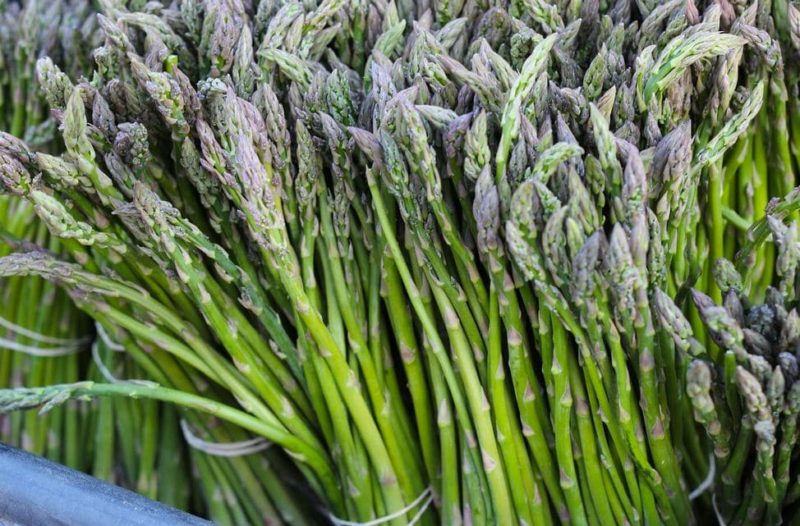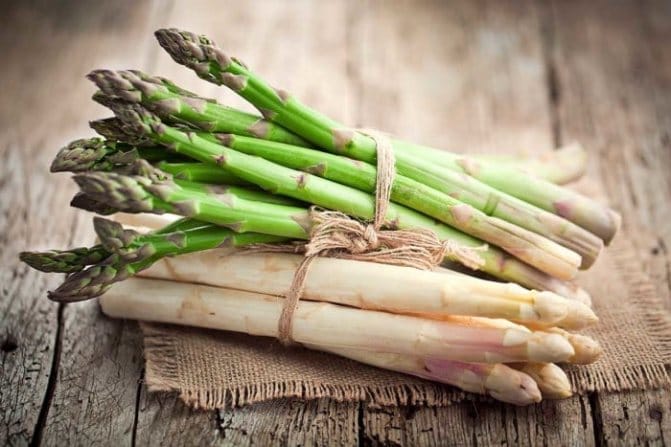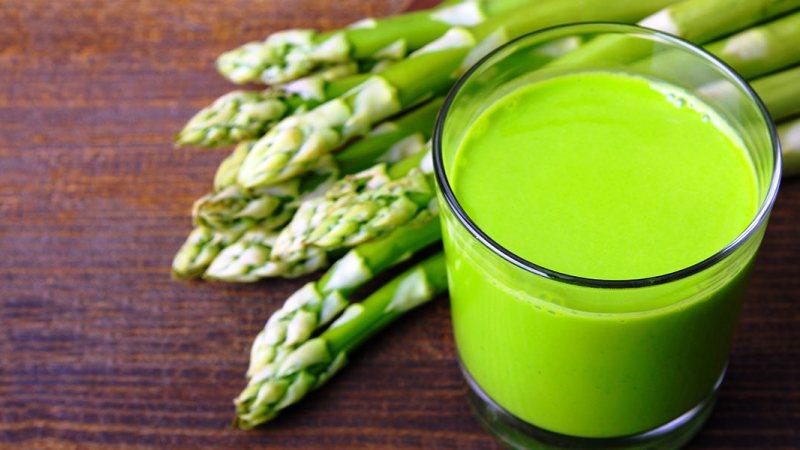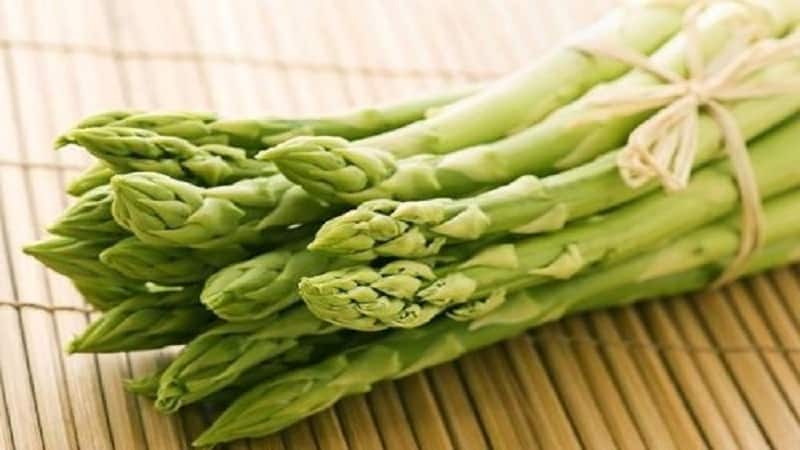Features of the use of asparagus officinalis
Young shoots of asparagus (asparagus) are popular among gourmets. There are many different recipes that allow you to prepare tasty and healthy dishes from this plant, but not everyone knows about its medicinal and preventive properties.
Composition and medicinal properties of asparagus officinalis
Asparagus medicinal, or ordinary, contains amino acids, coumarins, saponins, organic acids, carotenoids and vitamins. Roots, foliage, branches, berries and young shoots have healing properties.
Vitamin composition of shoots (per 100 g):
- PP - 1 mg;
- A - 83 mcg;
- B1 - 0.1 mg;
- B2 - 0.1 mg;
- B4 (choline) - 16 mg;
- B5 - 0.274 mg;
- B6 - 0.091 mg;
- B9 - 52 mcg;
- E - 2 mg;
- C - 20 mg;
- K - 41.6 μg;
- beta-carotene - 0.5 mg.
Macro- and microelements:
- magnesium - 20 mg;
- potassium - 196 mg;
- calcium - 21 mg;
- silicon - 98 mg;
- sodium - 2 mg;
- phosphorus - 62 mg;
- iron - 0.9 mg;
- manganese - 0.15 mg;
- zinc - 0.6 mg;
- copper - 0.17 mg;
- selenium - 6.1 mcg;
- fluoride - 21.9 mcg.
Nutritional value per 100 g:
- calorie content - 21 kcal;
- fats - 0.1 g;
- proteins - 1.9 g;
- dietary fiber - 1.5 g;
- carbohydrates - 3.1 g;
- water - 92.7 g;
- organic acids - 0.1 g;
- ash - 0.6 g;
- starch - 0.9 g.
Useful properties of asparagus:
- antispasmodic;
- blood purifying;
- diuretic;
- laxative;
- anti-inflammatory;
- pain reliever;
- vasodilator;
- choleretic;
- soothing;
- antifungal.
As a result of periodic consumption of young asparagus shoots, the following occurs in the body:
- the functioning of the cardiovascular, digestive and urinary systems is normalized;
- chlorides and phosphates are removed, and crystalline formations are removed from the ureters and kidneys;
- the immune system is stimulated;
- appetite increases;
- headache decreases.
On the picture - asparagus medicinal.

Benefits for women (including pregnant and lactating women)
The chemical composition of asparagus is favorable for the female body:
- improves skin condition, is useful for skin diseases (dermatitis, psoriasis, allergic dermatosis, etc.);
- maintains youth;
- regulates metabolic processes;
- removes toxins;
- helps reduce body weight.
Plant contains minerals and vitamins that contribute to the proper development of the fetus, including its nervous system. Therefore, the use of shoots during pregnancy is recommended.
Important! Asparagus reduces swelling caused by toxicosis.
During pregnancy and lactation, women's need for biologically active elements (nutrients) increases. The potassium, zinc, iron, sulfur and phosphorus contained in the perennial are easily absorbed by the body and stimulate metabolic processes, which is very important during breastfeeding. For hepatitis B, drinks and dishes prepared from a decoction of roots and young sprouts are especially useful.
For men
Asparagus has a healing effect for gout, which is most often found in men. Its use is beneficial for potency and blood circulation in the genitourinary tract. The chemical composition of the plant increases performance and normalizes the functions of the genital organs. Vitamin E stimulates the synthesis of hormones and serves as a prevention of chronic fatigue syndrome.
To solve intimate problems and increase potency, it is important to consume asparagus regularly or at least 3 days in a row.
For the elderly
Benefits of asparagus for older people:
- regulation of cardiovascular system functions;
- decreased blood pressure;
- preventing blood clotting;
- prevention of diabetes development;
- prevention of atherosclerosis.
For children
Asparagus is allowed to be included in the diet of children aged 10 months and older. Minerals and vitamins in its composition are required for the full growth of a young body. For example, potassium is involved in the contraction of skeletal and smooth muscles, and lysine is required for protein synthesis and the proper functioning of the immune system. For teenagers, the vegetable is recommended for the prevention of acne.
Applications of asparagus

Asparagus is used in various fields. In addition to cooking, it is used in official and folk medicine and cosmetology.
In official medicine
In a number of Latin American and European countries, plant rhizomes are included in the Pharmacopoeia and are actively used in pharmacology and practical medicine. Asparagus is effective in the treatment of rheumatism, diabetes, gout, whooping cough, kidney and respiratory diseases, and is used as a diuretic.
Reference. Asparagus is used in therapeutic dietetics: young sprouts are included in patients’ diets to improve digestion and increase appetite.
The plant is recommended for atherosclerosis, renal edema, pathologies of the prostate gland, bladder and cardiovascular system. The essence prepared from fresh young sprouts is used as a laxative, diuretic, sedative, choleretic and hypotensive agent.
In folk medicine
From asparagus prepare infusions and decoctions used for medicinal and prophylactic purposes. The drugs regulate the functioning of the gastrointestinal tract, liver, kidneys, cardiovascular and endocrine systems. Due to their calming effect, they are used for epilepsy.
Attention! The duration of therapy with asparagus preparations is no more than 10 days. Otherwise, there is a risk of allergic reactions.
In cosmetology and dermatology
The plant has disinfecting properties, so it is used to eliminate acne and inflammation. Fresh juice rejuvenates, nourishes and moisturizes the skin. To prepare medicinal masks, asparagus shoots are crushed and mixed with dairy products, fruits, vegetables and essential oils.
In other areas
Asparagus is a common product in nutrition and cooking. The asparagus diet is prescribed to relieve swelling, normalize metabolism, and get rid of excess salts. Due to its low calorie content, the plant is used to prepare dishes that promote losing weight.
In cooking, young shoots are boiled, baked, stewed, canned and frozen. They make delicious and healthy soups, salads, side dishes, drinks and desserts.
The use of asparagus officinalis in folk medicine

Infusions and decoctions of asparagus are used to treat various diseases.
Infusion for fever with diuretic effect
You will need:
- 1.5 tbsp. l. dried asparagus root, ground to a powder;
- 250 ml water.
Pour boiling water over the powder and leave for 15–20 minutes. Then filter and take 1 tbsp 3 times a day.
Decoction for arthralgia and rheumatism
Cooking method:
- Dry young asparagus shoots and grind to a powder.
- Pour water (15 g per 250 ml).
- Simmer for 30 minutes in a water bath.
- Give the opportunity to stand.
Use the decoction 3-4 times a day, 50 ml.
Therapeutic collection for cystitis and edema
To prepare the collection, mix asparagus root, strawberry leaves and goldenrod herb in a ratio of 3:1:2. For 10 g of mixture you will need 500 ml of water.
Attention! The collection should not be used during pregnancy, breastfeeding and individual intolerance to components. It is not recommended to give it to children and use it for glomerulonephritis.
Pour asparagus with 1/2 liter of water, bring to a boil, reduce heat and simmer under the lid for 20–30 minutes. Hot broth is poured over strawberries and goldenrod (during cooking, the beneficial substances in the tender parts of the plants are destroyed). If the water has evaporated greatly, add boiling water to 500 ml. Leave for 10–15 minutes. 1/2 tbsp. Take 10 minutes before meals 3-4 times a day.
Decoction for flu
Place 20 g of dry asparagus in ½ liter of water, place on low heat and boil for 5-7 minutes. Infuse at room temperature, filter and take 4 times a day, 130 ml before meals.
Infusion of young shoots
To obtain a diuretic, decongestant and renal agent, crushed asparagus shoots are poured with boiling water in a proportion of 15 g per 225 ml. After cooling, pass through a filter and take 20 ml 3 times a day.
Root decoction and syrup for gout
To prepare the decoction, crushed asparagus rhizome is poured with water (10 g per 500 ml), brought to a boil and simmered under the lid for 20–30 minutes. Strain and take 20 ml 3 times a day. The course of treatment is about 1 month.
Attention! The shelf life of all decoctions and infusions is 1 day.
To make syrup, the rhizome is boiled over medium heat, without letting the water boil, to 1/2 of the original volume.Then add sugar (1:1) and boil until it is completely dissolved. Dosage - 1 tbsp. l. every 4 hours. Store the syrup for 1 year in an airtight container in a cool, dark place.
Decoction for tachycardia
The medicine is prepared from different parts of asparagus in several stages:
- 10 g of dry ground roots are brewed with 500 ml of hot water.
- Boil over low heat for 1-2 minutes.
- Add 5 g of dry shoots to the decoction.
- Cover tightly with a lid and leave to infuse for 2-3 hours, then filter.
The product is taken 3 times a day before meals, the recommended dosage is 1/2 tbsp. It will also help with hypertension.
Calming Infusion
Pour 250 ml of boiled water into a thermos and add 5 g of chopped rhizome (add sugar if desired). Leave for 10–12 hours, strain and take 1/4 tbsp. 3-4 times a day.
Other
To obtain a decoction for allergies and relieve swelling, combine:
- 1 part asparagus roots;
- 1 part calendula flowers;
- 1 part nettle leaves;
- 1 part of the herb tripartite.
For 500 ml of water take 4 tsp. mixtures. Pour the asparagus decoction over the herbs and leave for 10–15 minutes. Take 3-4 times a day, 1 tbsp. Nettle will relieve itching, the string will relieve allergic reactions and remove inflammation, and calendula will normalize the functioning of the lymphatic system and relieve swelling.
Important! The collection is not recommended for use in cases of impaired blood clotting and hypotension.
To prepare an infusion of asparagus berries for sexual impotence, you will need:
- 7 asparagus fruits (fully ripe);
- 250 ml boiling water.
Pour boiling water over the berries and leave for 10–15 minutes. Drink 1 tbsp. l. 4 times a day.
A decoction for the treatment of tachycardia, cardioneurosis and the elimination of toxic chills is prepared from 15 g of dry asparagus shoots and 300 ml of boiling water.The mixture is infused for 10–15 minutes, filtered and taken 250 ml three times a day before meals.
Rejuvenating and anti-inflammatory face masks are prepared from asparagus. To do this, mix:
- 1 tbsp. l. chopped shoots;
- 3 tbsp. l. honey;
- 3 drops lemon essential oil.
The mixture is applied to previously cleansed skin. Keep the mask for 30 minutes, then wash off with warm water.
Anti-wrinkle recipe: 2 tsp. asparagus juice and 1 tsp. one of the oils: argan, almond or olive. Cotton pads are soaked in the mixture and placed over the eyes. After half an hour, wash off with warm water.

Possible harm and contraindications
Asparagus is not recommended for use if:
- individual intolerance;
- allergies;
- exacerbation of pathologies of the gastrointestinal tract: ulcers, gastritis.
Although the plant treats urolithiasis, it can provoke it in people who have a genetic predisposition to it.
It is recommended to avoid eating asparagus in the following cases:
- taking medications that thin the blood;
- increased gas formation;
- presence of advanced gout.
Excessive consumption of asparagus is contraindicated even for healthy people due to the likelihood of causing harm to the body. It is important to treat vegetables with great caution during pregnancy and breastfeeding.
Conclusion
Pharmaceutical asparagus, or medicinal, is a useful plant used in various fields: from cooking to cosmetology and medicine. However, to obtain maximum benefits when preparing dishes and medicinal preparations, it is important to adhere to the recommendations specified in the recipes.